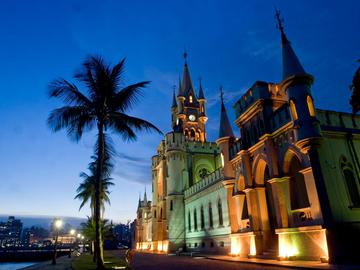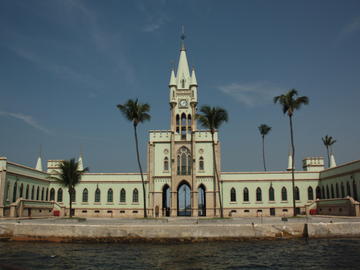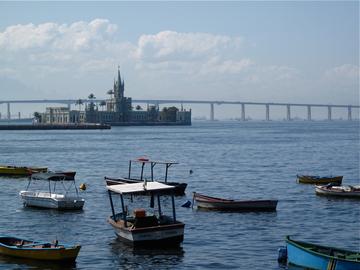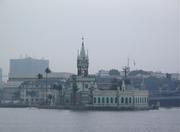Picture
More information on Ilha Fiscal in Rio de Janeiro

Description: Ilha Fiscal in Rio de Janeiro
The island was first called "Ilha Fiscal Rat. The name referred to the large number of mice that had been fleeing from snakes from Snake Island. There, in another version, a few gray stones scattered about the island that resembled rats at bay.
Castle Island was designed by engineer Joseph Del Vecchio Adoph to the Ministry of Finance that there was intended to have a customs post. Del Vecchio, who was director of the ministry of works, a project developed in neo-Gothic castles with inspiration from the fourteenth century, in Auvergne, France. The project was awarded the Gold Medal at the exhibition of the Imperial School of Fine and was praised by the Emperor as a delicate case, worthy of a brilliant jewel, "referring to its privileged location and beauty of Guanabara Bay.
The construction was performed with the utmost quality and the professionals who worked, each in his office, deserve special mention: the work is monumental in AntonioTeixeira Ruiz, Moreira de Carvalho took charge of the mosaic floor of the turret, an exquisite work done with various types wood. The windows were imported from England, the tower clock is Krussman and Co., the electrical appliances of Seon Rode. Decorative painting on the wall is Frederick Steckel and needles were cast by Manuel Joaquim Moreira and Co. The building was inaugurated on Fiscal Island in early 1889 by the emperor.
In the revolt of the Navy in 1893 to Fiscal Island was badly damaged by bullets that hit the walls and damaged the windows and furniture. After a few years the building was passed from the Ministry of Finance to the Ministry of the Navy, in an exchange made in 1913.
The famous dance of the Fiscal Island, was an event to honor the crew of the Chilean battleship Almirante Cochrane, to about 5000 guests. With this approval, the Empire strengthened the ties of friendship with Chile and tried to rebuild the prestige of the Monarchy, quite shaken by the Republican propaganda. The biggest party previously held in Brazil occurred shortly after the inauguration of the island. There was much talk of the music (waltz and polka), and the menu (a huge amount of bottles of wine and exotic foods) this season. The participants' behavior was extensively exploited (the press at the time - sec. XIX - reported that underwear were found on the island after the party), which still attracts curious historians today. The luxury and extravagance with which the guests had generated all kinds of commentaries.
The republic was proclaimed six days after the dance, and the emperor embarked on the same Pharoux Pier where the ferry departed to take guests to the dance. It bears mention that Pharoux pier, in downtown Rio, is today known as Plaza Fifteen, where he recently recovered the steps used for the shipment to the island. In 2001 the area has undergone intensive restoration work, coordinated by the Institute of Historical and Artistic Heritage (IPHAN). From the works, was recovered the splendor of the painted decoration of the ceiling, walls and parquet floors of the tower. Also outside the building returned to its original color display. From Thursday to Sunday, guided tours let you explore every corner of the building, a favorite of King Pedro II. Among the attractions, the halls which house permanent and temporary exhibitions that reveal the history of the Island and the Navy, the collection of stained glass and stonework - columns, arches, finials and imperial symbols.
The tour starts in style: from the quay at the Cultural Center of the Navy, the small cross is made on board the schooner Nogueira da Gama.
Address: Avenida Alfredo Agache, at the end of Praça Quinze - Center
http://www.rio.rj.gov.br/web/riotur/exibeconteudo?article-id=157642
Photo by: PedroKirilos
More Photos of Picture




